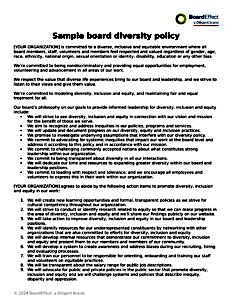How to write a board diversity policy — free guide & template
Diversity strengthens nonprofit boards. When board members of different backgrounds, skills and talents come together at the board table, they spur more creative and innovative decision-making. They bring different viewpoints and information that benefit their organization and the people they serve.
One of the best ways to ensure diversity among board members is to create and formalize a board diversity policy .
Nonprofit and mission-driven organization boards should create a policy that reflects the values and ethics that underpin their organizations. If this is the organization’s first foray into diversity, equity and inclusion (DEI) policy, the board will want to include diversity goals for the organization as well as for the makeup of the board.
Putting together a board diversity policy shows that the board is leading by example and setting expectations for the organization.
A good board policy explicitly outlines the board’s definition of diversity, the goals that the board hopes to achieve, and the steps that board will take to achieve those goals.
Why diversity matters in boardrooms
According to the National Council of Nonprofits, “Having diverse perspectives on your nonprofit’s board of directors is critically important. Each person will bring their own personal and professional contacts and life experiences to their service on a nonprofit board.”
It’s hard to disagree with the importance of diverse perspectives on your board. Historically, many groups of people have been left out of decisions and preventing from becoming decision-makers. Societal changes are breaking up traditional power structures, and mission-driven organizations can be part of that transformation .
However, sometimes board members with the best intentions can unwittingly perpetuate a system that maintains a homogenous board makeup. A policy with goals and action items can push boards out of complacency to shake up the status quo. This will allow the board and the organization to reap the benefits of making more room for different voices and perspectives at the board table.
Key elements of a board diversity policy
Creating a good diversity policy requires the board to agree on the actions and goals of the policy. To do so, board members must be working with a shared understanding of the terms and definitions in the policy.
The first step is defining what you mean by diversity. It often refers to race, gender, age, ethnicity, culture. But it can also include diverse career experiences, education background or socioeconomic status. Perhaps it includes making sure your board reflects the community demographics it serves.
Bringing board members together requires that you also look at how you view inclusion, which has to do with whether diverse people feel valued in their positions on a nonprofit board . Inclusion in a nonprofit board meeting means asking diverse board members to actively engage in board discussions and to respect their opinions.
Once board members have a mutual understanding of the terms and an agreement of the goals, they are ready to write. Included in the policy should be:
- The board’s statement on why diversity is important.
- The plan to gather information and data, with a commitment to sharing that information with the organization.
- Concrete language and explicit goals.
- Immediate, short-term, and long-term deadlines.
- Accountability for the success of the policy goals, including audits , assessments, and action steps.
Pitfalls of board diversity policies
What to avoid when putting together your policy:
- A lack of concrete definitions and goals
- Being too vague or too prescriptive
- Straying from your organization’s values.
- Lack of follow up or accountability for meeting goals.
Template for a volunteer board diversity policy
Our template for a board diversity policy is a starting point. It’s a guide you can adapt according to your organization’s mission, vision, and values. This sample policy details the components of a board diversity policy, including a diversity and inclusion statement and some action items. The template can be quickly tailored to your organization and will allow your board to stay ahead of the curve and demonstrate your leadership in this critical area. It can even serve as a framework for integrating these best practices into your governance structure. Download our sample board diversity policy here .

How to implement a diversity policy: Time and effort will bring results
The process of creating a good diversity policy will take time. Diversity policies can range from something that’s fairly simple to policies that consist of many pages depending on the board’s decision and any other policies or requirements of the organization. Regardless of the length of your board diversity policy, BoardEffect provides a secure place to record your policy and your efforts in creating it.
If you have a committee or working group overseeing your DEI programs, they can use secure workrooms to collaborate and work together as they evolve these.
As the organization and other changes in society evolve, your board can vote to make changes to your diversity policy when they’re deemed appropriate. The most important thing is to ensure that your board diversity policy is more than words — you need to put it into force and abide by it in word and practice.
At Diligent, we understand the value diversity brings to a nonprofit, and we’ve designed BoardEffect to be a flexible solution to support your DE&I efforts. Whatever shape your organization takes, BoardEffect can be a valuable tool to collaborate, measure progress and document accomplishments.
Ed is a seasoned professional with over 12 years of experience in the Governance space, where he has collaborated with a diverse range of organizations. His passion lies in empowering these entities to optimize their operations through the strategic integration of technology, particularly in the realms of Governance, Risk, and Compliance (GRC).
